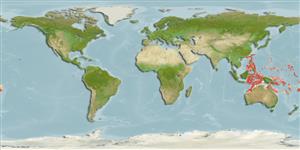>
Acropomatiformes (Oceanic basses) >
Acropomatidae (Lanternbellies, temperate ocean-basses)
Etymology: Doederleinia: Ludwig Döderlein; he described sharks species/Chlamydoselachus in Tokyo bay (1879-1881) working with Garman (See under Garmanella).
More on author: Hilgendorf.
Environment: milieu / climate zone / depth range / distribution range
นิเวศวิทยา
เกี่ยวกับทะเล,น้ำเค็ม สัตว์น้ำหน้าดิน; ระดับความลึก 100 - 600 m (Ref. 76993). Tropical; 25°N - 21°S, 115°E - 177°W (Ref. 57277)
Eastern Indian Ocean to Western Pacific: NW Japan to NW Australia.
ขนาด / น้ำหนัก / Age
Maturity: Lm ? range ? - ? cm
Max length : 40.0 cm TL เพศผู้/กระเทย; (Ref. 637); common length : 30.0 cm TL เพศผู้/กระเทย; (Ref. 9137)
เงี่ยงครีบหลัง (รวม): 9; ก้านครีบอ่อนที่หาง (รวม): 10; เงี่ยงครีบก้น 3; ก้านครีบอ่อนที่ก้น: 6 - 8. Body red above, ventrally white. Scales large, deciduous. Inside of mouth cavity black.
Feed on large crustaceans and mollusks. Utilized for human consumption (Ref. 637).
Life cycle and mating behavior
วัยเจริญพันธุ์ | การสืบพันธุ์ | การวางไข่ | เซลสืบพันธ์ของเพศเมีย(ไข่) | ความดกของไข่ | ตัวอ่อน
Paxton, J.R., D.F. Hoese, G.R. Allen and J.E. Hanley, 1989. Pisces. Petromyzontidae to Carangidae. Zoological Catalogue of Australia, Vol. 7. Australian Government Publishing Service, Canberra, 665 p. (Ref. 7300)
IUCN Red List Status (Ref. 130435)
Threat to humans
Harmless
Human uses
การประมง: การค้า
ข้อมูลเพิ่มเติม
ชื่อสามัญชื่อพ้องกลไกการเผาผลาญพลังงานผู้ล่าการศึกษาเกี่ยวกับผลกระทบของสารประกอบทางเคมีที่เป็นอันตรายต่อสิ่งมีชีวิต ประชากร และสิ่งแวดล้อมการสืบพันธุ์วัยเจริญพันธุ์การวางไข่การรวมกลุ่มวางไข่ความดกของไข่เซลสืบพันธ์ของเพศเมีย(ไข่)Egg development
อ้างอิงการเพาะเลี้ยงสัตว์น้ำประวัติการเพาะเลี้ยงสัตว์น้ำสายพันธุ์พันธุศาสตร์ElectrophoresesอัตราพันธุกรรมโรคการแปรรูปNutrientsMass conversion
เครื่องมือ
Special reports
Download XML
แหล่งที่มาจากอินเตอร์เน็ต
Estimates based on models
Preferred temperature (Ref.
123201): 11.4 - 21.3, mean 15.2 °C (based on 137 cells).
Phylogenetic diversity index (Ref.
82804): PD
50 = 1.0000 [Uniqueness, from 0.5 = low to 2.0 = high].
Bayesian length-weight: a=0.01148 (0.00708 - 0.01861), b=2.98 (2.84 - 3.12), in cm total length, based on LWR estimates for this species & (Sub)family-body (Ref.
93245).
ระดับชั้นอาหาร (Ref.
69278): 3.9 ±0.56 se; based on food items.
Generation time: 3.1 ( na - na) years. Estimated as median ln(3)/K based on 1
growth studies.
ความสามารถในการกลับคืนสู่ปกติ (Ref.
120179): ขนาดกลาง, เวลาต่ำสุดที่จะทำให้ประชากรเพิ่มขึ้นเป็น 2 เท่าใช้เวลา 1.4 - 4.4 ปี (K=0.3).
Fishing Vulnerability (Ref.
59153): Low to moderate vulnerability (33 of 100).
Nutrients (Ref.
124155): Calcium = 117 [73, 201] mg/100g; Iron = 1.05 [0.67, 1.62] mg/100g; Protein = 18.4 [17.5, 19.3] %; Omega3 = 0.305 [0.188, 0.495] g/100g; Selenium = 82.7 [45.2, 149.5] μg/100g; VitaminA = 20.5 [8.0, 50.2] μg/100g; Zinc = 0.99 [0.73, 1.39] mg/100g (wet weight);
